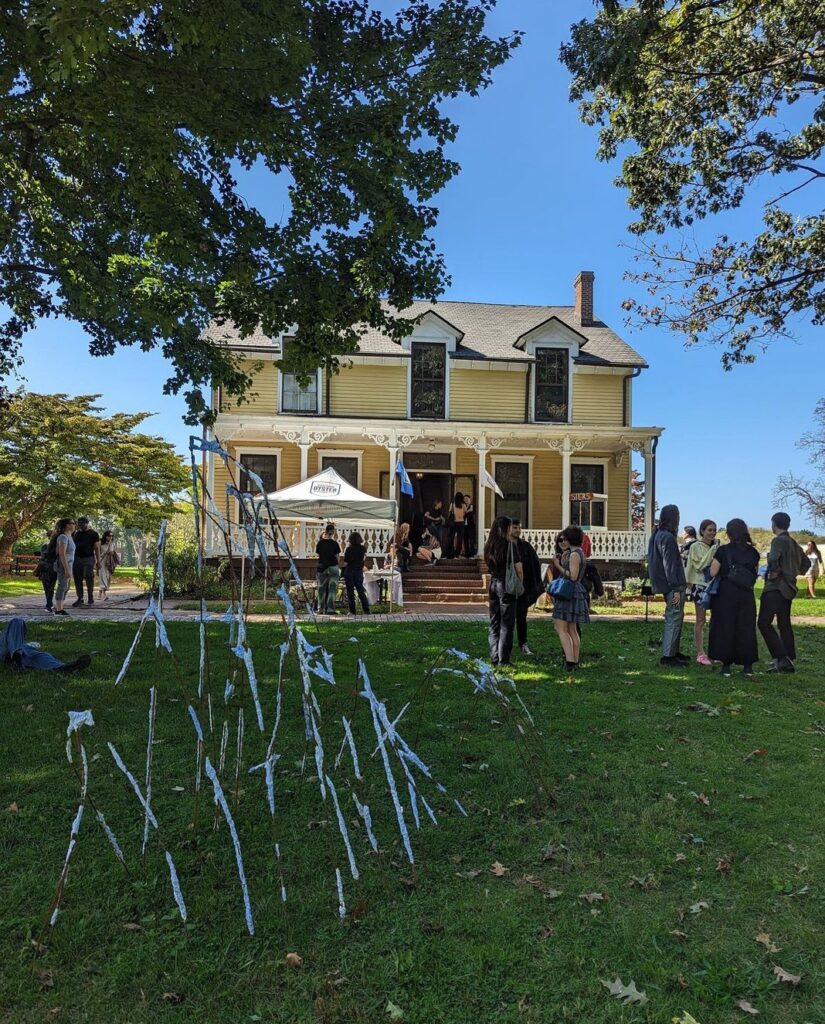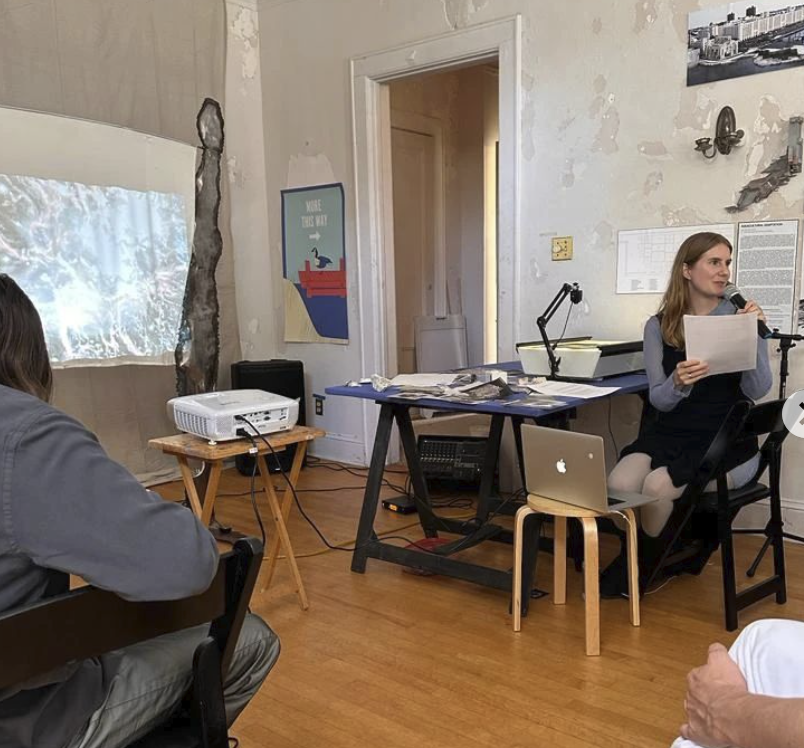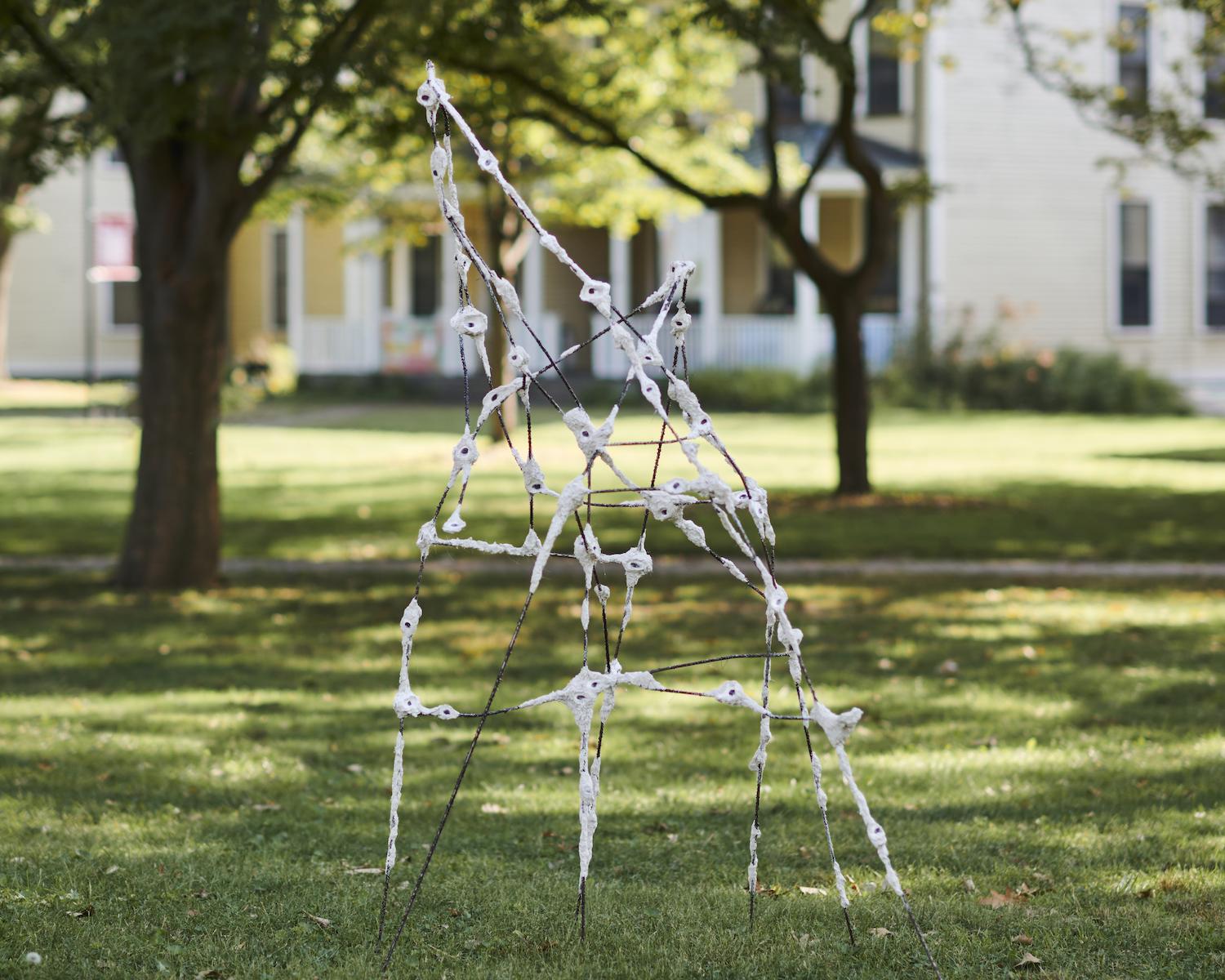On Governors Island, You Can Look into the “Eye” of an Oyster


Oysters, once ingeniously described by critic Travis Diehl as “bivalve Venus,” have an uncanny appeal in contemporary imaginations. Frequently associated with erotic and aesthetic metaphors, they seem to be a convenient embodiment of humans’ desires, fantasies, and introspections. After all, the marine species tread through life with instincts akin to humans: they glean molecules, bind with one another, find a surface to settle, and slowly build a shell to protect their soft self. Exploring precisely this life cycle of oysters, Swedish artist Linnéa Gad opens up the material history of oyster shells to a landscape of ecological interconnectedness.
Currently on view as part of The Immigrant Artist Biennial 2023, Gad’s “Shoals I-II” find themselves at the intersection of art, nature, and human intervention. Suitably, the works are installed on the lawn of Billion Oyster Project’s house on Governors Island, where the non-profit educates visitors about their activities to regenerate oyster reefs in the Hudson River. An alumna of Columbia University School of the Arts, Gad is currently an adjunct assistant professor of visual arts at the same institution. As her first public work, “Shoals” builds on her multi-year research into lime and synthesizes the various incarnations of calcium carbonate, harboring a habitat of alienation, restoration, and coagulation, for oysters and humans alike.

I saw the sculptures for the first time in person on a clear Sunday. After a few days of dreadful rainstorms, Governors Island seemed like the perfect, tranquil hideaway from the dampened roads of urban Manhattan. There they are two sculptures sprawling on a public lawn in slender, unfathomable forms—textured and enigmatic like Giacometti’s figurines. In the press photos, they can seem somewhat gnarly. Or perhaps I am just not very used to looking at oysters in the “eye,” which are also known, less poetically, as the mollusks’ adductor muscle scars. But in person, the sculptures—organically immersed in the surrounding nature—are serene, warm, and inviting.
The two sculptures share the use of welded metal, welding beads, lime mortar, oyster shells, and goat hair, with “Shoal I” being colored with the blue metamorphic rock, lapis lazuli, and “Shoal II” with Gofun Shirayuki, a white pigment manufactured from oyster shells. These seemingly unrelated materials unify under the general purview of the Earth’s carbon cycle, as calcium carbonate finds itself in a constant state of transformation through sedimentation, precipitation, and decomposition. According to the artist, oysters form their shells by binding together the calcium carbonate molecules from the ocean. At the time of their death, these shells are deposited on the ocean floor, turning into limestone after millions of years of compression. When tectonic plates collide, the limestone enters the Earth’s magma chamber and is eventually released into the atmosphere once again as CO2 during volcanic eruptions. At various stages during this process, humans’ construction-loving hands pick up oyster shells and limestone, transforming them into construction materials and pigments—the oftentimes overlooked but essential participants of our everyday lives.

To inaugurate the show, the artist presented a performative lecture entitled “Oysters as Eyes” in collaboration with musician Will Epstein. The audience was invited into a room with an empty oyster shell on each seat. The unique choice of “flyers” almost instantaneously engaged the audience with their tactility, as vessels and memorabilia of life. As Gad narrated the architectural, social, and ecological histories of oysters, she superimposed diagrams, photographs, texts, and found objects onto each other via a projector. She talked about shell middens, Sappho’s fragmented words, and the ocean’s infinite echo. In describing her research, a story of labor, materiality, and finding a constant within cycles of unstopping change emerged. The part-lecture, part-performance format imbued oyster lives with so much poetry, and the intimate connection between human life and the secrets of this marine creature became ever so clear.
The sound art accompanying Gad’s presentation was mostly ambient—pitches high and low were transmitted and physicalized via two cords connected to sound-conducting vibrators. These devices were placed on two chairs, each plating a group of oyster shells. As the conductors vibrate, the oyster shells were “resurrected” by the uncanny kinetic disturbance, vigorously shaking and bumping into each other. Surrounded by an abundance of tactile, visual, and audio stimulation, I cannot help but think in the terms of the Romantics.


As all quieted down, I went out on the porch, to overlook the lawn. In front of the house, there were a few metal crates full of empty shells from restaurants, waiting to be restored back into the ocean. Designed by the Billion Oyster Project, these gabions have internal pathways that allow fishes and crabs to traverse through the restored shells, thereby more accurately imitating how oyster reefs would function in nature. From a distance, “Shoals” were like the oyster-filled gabions—a delicate intervention to the shared lawn—rendering the viewer an earth-bound counterpart of the marine creatures. Later that evening, while scrolling through Instagram, I saw a photo of a child crawling underneath the sculpture as if they were an oyster.
Looking closely, the thin fibers of goat hair and the tiny lumps on the welded metal possess the dainty, inexplicable charm of vellus hair, a baby clover, or a nascent twig. Surrounding each biomorphic sculpture is a small world of unplanned randomness and surprises; there is a mushroom growing underneath “Shoal II,” and a glistening spider web quickly formed amid the sculpture’s fabric of neuron-like structures. “Shoals” witness and support the materialization of these micro-systems. With a deep sense of care and reverence for nature’s enigma, Gad’s work creates a magical moment when marine and terrestrial time become closely connected, soliciting reflections as to how we find ourselves in nature.
“Shoals I-II” are on view in Nolan Park on Governors Island until November 19, 2023. For more information about the 2023 edition of the Immigrant Artist Biennial: Contact Zone, please find the program here.
Art Spiel and Cultbytes are, for the second time, proud media sponsors of the biennial, and this review series is published as part of TIAB’s writer’s residency generously supported by Lesley Bodzy Studio and Fraser Birrell Grier, Esq.
You Might Also Like
What's Your Reaction?
Xuezhu Jenny Wang is a multilingual translator and content creator. In addition to writing about postwar and contemporary visual culture, she is working on a research project that focuses on mid-century interior design and mechanization.

